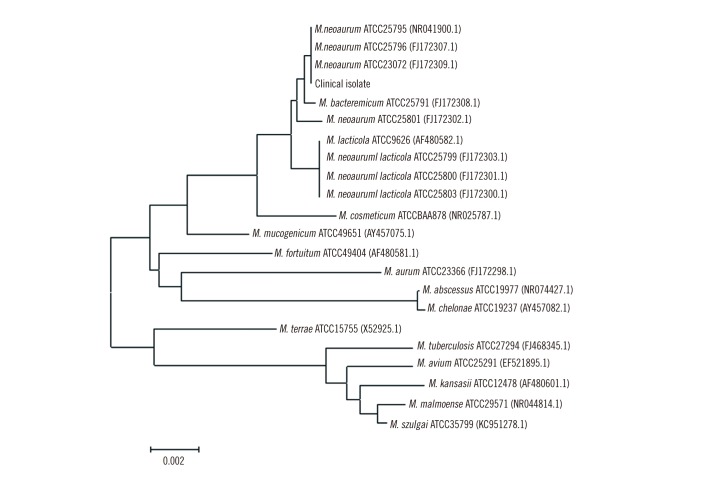Ann Lab Med.
2014 May;34(3):243-246. 10.3343/alm.2014.34.3.243.
Pulmonary Infection Caused by Mycobacterium neoaurum: The First Case in Korea
- Affiliations
-
- 1Department of Laboratory Medicine, Korean Institute of Tuberculosis, Osong, Korea.
- 2Department of Laboratory Medicine and Genetics, Soonchunhyang University College of Medicine, Cheonan, Korea. shinhb@schmc.ac.kr
- KMID: 1791928
- DOI: http://doi.org/10.3343/alm.2014.34.3.243
Abstract
- Mycobacterium neoaurum is rapidly growing mycobacteria that can cause human infections. It commonly causes bloodstream infections in immunocompromised hosts, and unlike other mycobacteria species, it rarely causes pulmonary infections. We confirmed the first pulmonary infection case in Korea caused by M. neoaurum using full-length 16S rRNA gene sequencing.
MeSH Terms
Figure
Reference
-
1. Brown-Elliott BA. Clinical and taxonomic status of pathogenic nonpigmented or late-pigmenting rapidly growing mycobacteria. Clin Microbiol Rev. 2002; 15:716–746. PMID: 12364376.
Article2. Brown-Elliott BA, Wallace RJ Jr. Mycobacterium: Clinical and laboratory characteristics of rapidly growing mycobacteria. In : Versalovic J, Carroll KC, Funke G, Jorgensen JH, Landry ML, Warnock DW, editors. Manual of clinical microbiology. 10th ed. Washington, DC: ASM press;2010. p. 525–538.3. Davison MB, McCormack JG, Blacklock ZM, Dawson DJ, Tilse MH, Crimmins FB. Bacteremia caused by Mycobacterium neoaurum. J Clin Microbiol. 1988; 26:762–764. PMID: 3366872.4. Lai CC, Tan CK, Chen CC, Hsueh PR. Mycobacterium neoaurum infection in a patient with renal failure. Int J Infect Dis. 2009; 13:e276–e278. PMID: 19119036.5. Heckman GA, Hawkins C, Morris A, Burrows LL, Bergeron C. Rapidly progressive dementia due to Mycobacterium neoaurum meningoencephalitis. Emerg Infect Dis. 2004; 10:924–927. PMID: 15200833.6. Zanetti S, Faedda R, Fadda G, Dupré I, Molicotti P, Ortu S, et al. Isolation and identification of Mycobacterium neoaurum from a patient with urinary infection. New Microbiol. 2001; 24:189–192. PMID: 11346303.7. Morimoto Y, Chan ED, Heifets L, Routes JM. Pulmonary infection with Mycobacterium neoaurum identified by 16S ribosomal DNA sequence. J Infect. 2007; 54:e227–e231. PMID: 17306883.8. Griffith DE, Aksamit T, Brown-Elliott BA, Catanzaro A, Daley C, Gordin F, et al. An official ATS/IDSA statement: diagnosis, treatment, and prevention of nontuberculous mycobacterial diseases. Am J Respir Crit Care Med. 2007; 175:367–416. PMID: 17277290.
Article9. Tamura K, Peterson D, Peterson N, Stecher G, Nei M, Kumar S. MEGA5: molecular evolutionary genetics analysis using maximum likelihood, evolutionary distance, and maximum parsimony methods. Mol Biol Evol. 2011; 28:2731–2739. PMID: 21546353.
Article10. Clinical and Laboratory Standards Institute. Approved standard, M24-A2E. Susceptibility testing of mycobacteria, nocardiae, and other aerobic actinomycetes. Wayne, PA: Clinical and Laboratory Standards Institute;2011.11. Korea Center for Disease Control and Prevention (KCDC). Current status of nontuberculous mycobacterial infection. Public Health Wkly Rep. 2009; 2:389–393. http://www.cdc.go.kr/CDC/info/CdcKrInfo0301.jsp?menuIds=HOME001-MNU1154-MNU0005-MNU0037&q_type=&year=2009&cid=12296&pageNum=.12. Tsukamura M. A new species of rapidly growing, scotochromogenic mycobacteria. Mycobacterium neoaurum. Med Biol. 1972; 85:229–233.13. Martin LK, Lawrence R, Kossard S, Murrell DF. Cutaneous Mycobacterium neoaurum infection causing scarring alopecia in an immunocompetent host. Br J Dermatol. 2007; 157:204–206. PMID: 17501949.14. Omoruyi OJ, Ip WY, To KK. Hand infection due to Mycobacterium neoaurum. J Hand Surg Eur Vol. 2012; 37:574–575. PMID: 22457251.15. Becker ML, Suchak AA, Wolfe JN, Zarychanski R, Kabani A, Nicolle LE. Mycobacterium neoaurum bacteremia in a hemodialysis patient. Can J Infect Dis. 2003; 14:45–48. PMID: 18159425.16. García-Agudo L, Jesús I, Rodríguez-Iglesias M, García-Martos P. Evaluation of INNO-LiPA mycobacteria v2 assay for identification of rapidly growing mycobacteria. Braz J Microbiol. 2011; 42:1220–1226. PMID: 24031745.
Article17. Simmon KE, Low YY, Brown-Elliott BA, Wallace RJ Jr, Petti CA. Phylogenetic analysis of Mycobacterium aurum and Mycobacterium neoaurum with redescription of M. aurum culture collection strains. Int J Syst Evol Microbiol. 2009; 59:1371–1375. PMID: 19502318.18. Brown-Elliott BA, Wallace RJ Jr, Petti CA, Mann LB, McGlasson M, Chihara S, et al. Mycobacterium neoaurum and Mycobacterium bacteremicum sp. nov. as causes of mycobacteremia. J Clin Microbiol. 2010; 48:4377–4385. PMID: 20881180.
- Full Text Links
- Actions
-
Cited
- CITED
-
- Close
- Share
- Similar articles
-
- Acute pneumonia caused by mycobacterium intracellulare
- A Case of Pulmonary and Endobronchial Mycobacterium avium Infection Presenting as an Acute Pneumonia in an Immunocompetent Patient
- Pulmonary infection with Mycobacterium celatum in immunocompetent host: The first case report in Korea
- Mycobacterium Szulgai Pulmonary Infection: Case Report of an Uncommon Pathogen in Korea
- Report of a Case of Pulmonary Mycobacteriosis Caused by Mycobacterium Chelonei Subsp. Abscessus


